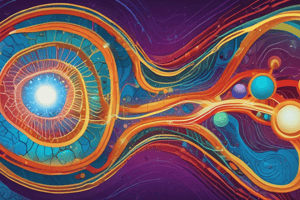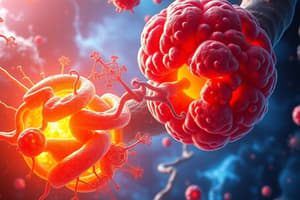Podcast
Questions and Answers
What is the primary role of ATP in cellular activities?
What is the primary role of ATP in cellular activities?
- To provide the energy for cellular processes (correct)
- To store genetic information
- To build structural components of the cell
- To catalyze biochemical reactions
Which of the following is the correct sequence of the stages in cellular respiration?
Which of the following is the correct sequence of the stages in cellular respiration?
- Glycolysis → Citric acid cycle → Oxidative phosphorylation (correct)
- Citric acid cycle → Glycolysis → Oxidative phosphorylation
- Oxidative phosphorylation → Glycolysis → Citric acid cycle
- Glycolysis → Oxidative phosphorylation → Citric acid cycle
In eukaryotic cells, where does glycolysis take place?
In eukaryotic cells, where does glycolysis take place?
- On the endoplasmic reticulum
- In the intermembrane space of the mitochondria
- Within the mitochondrial matrix
- In the cytoplasm (correct)
What is the main function of the mitochondrial inner membrane?
What is the main function of the mitochondrial inner membrane?
What is the role of NADH and FADH2 in oxidative phosphorylation?
What is the role of NADH and FADH2 in oxidative phosphorylation?
What is the importance of the proton gradient established during the electron transport chain?
What is the importance of the proton gradient established during the electron transport chain?
Which of the following processes is directly powered by ATP hydrolysis?
Which of the following processes is directly powered by ATP hydrolysis?
How many membranes does a mitochondrion have?
How many membranes does a mitochondrion have?
What is the main purpose of cellular respiration?
What is the main purpose of cellular respiration?
In which stage of cellular respiration is most ATP produced?
In which stage of cellular respiration is most ATP produced?
What is the role of cellular compartments in energy conversion?
What is the role of cellular compartments in energy conversion?
What role does ATP synthase play in cellular respiration?
What role does ATP synthase play in cellular respiration?
What is the chemical equation that summarizes cellular respiration?
What is the chemical equation that summarizes cellular respiration?
Which part of the mitochondrion contains mitochondrial DNA and ribosomes?
Which part of the mitochondrion contains mitochondrial DNA and ribosomes?
Which of the following is an example of a cell using ATP for mechanical work?
Which of the following is an example of a cell using ATP for mechanical work?
What is the primary outcome of glycolysis?
What is the primary outcome of glycolysis?
What is the role of the intermembrane space in mitochondria?
What is the role of the intermembrane space in mitochondria?
During electron transport, what is the direct role of oxygen?
During electron transport, what is the direct role of oxygen?
Which of the following steps in cellular respiration does NOT directly produce ATP?
Which of the following steps in cellular respiration does NOT directly produce ATP?
What is the significance of the folded inner membrane (cristae) of the mitochondrion?
What is the significance of the folded inner membrane (cristae) of the mitochondrion?
What is the primary function of ATP regeneration in cells?
What is the primary function of ATP regeneration in cells?
If a cell suddenly lost its ability to carry out the citric acid cycle, what would be the most immediate consequence?
If a cell suddenly lost its ability to carry out the citric acid cycle, what would be the most immediate consequence?
Which of the following is NOT a major energy requirement of cells?
Which of the following is NOT a major energy requirement of cells?
What process links the citric acid cycle to the electron transport chain?
What process links the citric acid cycle to the electron transport chain?
Where does the conversion of pyruvate to Acetyl CoA occur?
Where does the conversion of pyruvate to Acetyl CoA occur?
Which of the following statements accurately describes the chemiosmosis process?
Which of the following statements accurately describes the chemiosmosis process?
How does cellular respiration differ between plants and animals?
How does cellular respiration differ between plants and animals?
Which of the following uses ATP to maintain order within the cell?
Which of the following uses ATP to maintain order within the cell?
Flashcards
Cellular Respiration
Cellular Respiration
The process where plants and animals convert energy from organic molecules into ATP.
ATP (Adenosine Triphosphate)
ATP (Adenosine Triphosphate)
A molecule that carries energy within cells for metabolism.
Mechanical Work
Mechanical Work
Supply energy for muscle movement and cellular transport.
Making New Materials
Making New Materials
Signup and view all the flashcards
Transport
Transport
Signup and view all the flashcards
Maintain Order
Maintain Order
Signup and view all the flashcards
Mitochondria
Mitochondria
Signup and view all the flashcards
Outer Mitochondrial Membrane
Outer Mitochondrial Membrane
Signup and view all the flashcards
Inner Mitochondrial Membrane
Inner Mitochondrial Membrane
Signup and view all the flashcards
Cristae
Cristae
Signup and view all the flashcards
Intermembrane Space
Intermembrane Space
Signup and view all the flashcards
Matrix
Matrix
Signup and view all the flashcards
Glycolysis
Glycolysis
Signup and view all the flashcards
Pyruvate Oxidation
Pyruvate Oxidation
Signup and view all the flashcards
Citric Acid Cycle (Krebs Cycle)
Citric Acid Cycle (Krebs Cycle)
Signup and view all the flashcards
Electron Transport Chain
Electron Transport Chain
Signup and view all the flashcards
Chemiosmosis
Chemiosmosis
Signup and view all the flashcards
ATP Synthase
ATP Synthase
Signup and view all the flashcards
Glucose + Oxygen
Glucose + Oxygen
Signup and view all the flashcards
ATP Function
ATP Function
Signup and view all the flashcards
ATP Regeneration
ATP Regeneration
Signup and view all the flashcards
Cellular Respiration Products
Cellular Respiration Products
Signup and view all the flashcards
Glucose > Pyruvate
Glucose > Pyruvate
Signup and view all the flashcards
Study Notes
Lecture 6 Objectives
- Identify the major energy needs of plant and animal cells
- Describe the basic structure and function of the mitochondrion
- Describe the importance of cellular compartments in energy conversion.
- Outline the mechanism of ATP synthesis and the role played by ATP in powering cellular activity.
Energy Flow
- Photosynthesis occurs only in plants
- Cellular respiration occurs in both plants and animals
- Photosynthesis uses CO2 + H2O and light energy, to generate organic molecules + O2
- Cellular respiration breaks down organic molecules and generates ATP
Adenosine Triphosphate (ATP)
- ATP is an energy carrier
- ATP's structure includes Adenine, Ribose, and a Triphosphate group
Energy Requirements of the Cell
- Energy is needed for :
- Mechanical work e.g. motor proteins
- To make new materials e.g. growth and replacement
- Transport e.g. transport of molecules across membranes
- As well as to maintain order
Mitochondria
- The site of cellular respiration is the mitochondria
- The conversion of chemical energy is shown as: C6H12O6 + 6O2 → 6CO2 + 6H2O + Energy
- Mitochondria are organelles that are present in numbers from 1-1000's per cell
- The quantity depends on energy demand
- Consist of mitochondrial DNA & ribosomes
- Produces some, but not all mitochondrial proteins
- Have two membranes
- Inner and outer
- inner membrane is highly folded (cristae)
- Have two compartments that are functionally important:
- Matrix, inside the inner membrane
- Intermembrane space
Overview of Cellular Respiration
- Harvesting chemical energy from glucose occurs in three stages, each in a different location
- Compartments of the mitochondrion are essential for cellular respiration
Cellular Respiration: Glycolysis
- Glycolysis is the first stage of Cellular Respiration
- Glycolysis occurs in the cytosol
- Sugar or glucose (6 C molecule) is converted into two pyruvate molecules (2 x 3 C molecules)
- Generates 2ATP and electrons are transferred to the high energy electron carrier - NAD+ making NADH
Cellular Respiration: Pyruvate Oxidation & Citric Acid Cycle
- Second Stage of cellular respiration
- Takes place in the Mitochondrial Matrix
- Through Pyruvate Oxidation & the Citric Acid Cycle, 2 pyruvate molecules are converted to 2 Acetyl CoA molecules that enter the citric acid cycle
- Energy carrier ATP and high energy electron carriers NADH & FADH2 are outputted by this stage
- C6H12O6 + 6O2-> 6CO2 + 6H2O + Energy
Cellular Respiration: Stages 1 & 2 - Summary
- Cellular respiration starts with glucose
- Outputs include ATP and some NADH & FADH2
Cellular Respiration: Oxidative Phosphorylation
- Third stage of cellular respiration
- Occurs in the Inner Membrane of the Mitochondrion
- Has two parts
- Electron transport
- Chemiosmosis
The Inner Mitochondrial Membrane
- The inner membrane is highly folded (Cristae) and functionally important
- Intermembrane space is also functionally important
Cellular Respiration: Oxidative Phosphorylation Part 1, the Electron Transport Chain
- Electron carriers NADH and FADH2 shuttle high energy electrons to the inner mitochondrial membrane
- The Electrons then move through protein complexes embedded in the inner membrane
- Protons (H+) are pumped across the membrane as the electrons move
Cellular Resiration: Proton Gradient
- Protons (H+) accumulate in the intermembrane space
- This concentration gradient on either side of the inner mitochondrial membrane
- The mitochondrion's compartments are imporant for the process
- This accumulation of protons is crucial to the next step
Cellular Respiration: Chemiosmosis
- Chemiosmosis is the second part of oxidative phosphorylation
- The inner mitochondrial membrane contains the protein complex ATP synthase
- Protons move from a high to low concentration through ATP synthase, and this process results in ATP production from ADP
- ADP + Pi -> ATP
Summary of Cellular Respiration
- Chemical energy is converted from one form to another
- Glucose becomes ATP, an energy carrier used by the cell
- The mitochondrial structure enables the proton gradient to be established across the inner membrane, which drives ATP production
- Glucose and oxygen are consumed during cellular respiration
- Cellular respiration produces carbon dioxide, water, and ATP
Adenosine Triphosphate (ATP)
- ATP powers cellular activity and enables a controlled release of energy
Adenosine Triphosphate (ATP)
- The regeneration of ATP is essential
- The cell constantly uses and regenerates ATP
Lecture Summary
- Plant and animal cells require energy for growth and maintenance – The mitochondrion is the organelle where chemical energy is converted into a useable form (ATP)
- Mitochondrial membrane structure and compartments are essential for different stages of cellular respiration
- ATP synthesis in cellular respiration occurs in oxidative phosphorylation and requires ATP synthase and high energy electrons from earlier stages (glycolysis, pyruvate oxidation, and citric acid cycle)
- ATP, the output of cellular respiration, is the main energy carrier of the cell
Studying That Suits You
Use AI to generate personalized quizzes and flashcards to suit your learning preferences.




